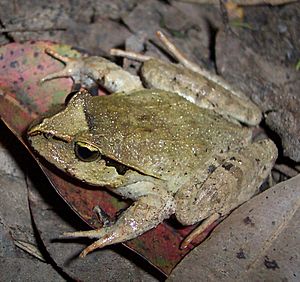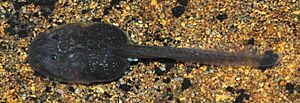Fletcher's frog facts for kids
Quick facts for kids Fletcher's frog |
|
|---|---|
 |
|
| Conservation status | |
| Scientific classification | |
| Genus: |
Lechriodus
|
| Species: |
fletcheri
|
 |
|
| Range of the Fletcher's frog | |
- "Fletcher's frog" may also refer to the long-thumbed frog (Limnodynastes fletcheri)
The Fletcher's frog or sandpaper frog (Lechriodus fletcheri) is a special kind of ground frog. It lives in eastern Australia, from South-east Queensland down to Ourimbah in New South Wales. This frog makes its home in rainforests and wet sclerophyll forests, which are types of forests found near the coast and in mountain ranges.
What Does It Look Like?
This is a medium-sized frog. It can grow to be about 50 millimeters (about 2 inches) long. Its back is usually brown, but the color can change from a light tan to a dark or reddish brown.
The frog's skin feels rough, almost like sandpaper! It has raised lines, called skin folds, that run down its back. You might also notice a clear triangle shape of lighter brown on its head, right between its eyes and snout.
A dark line starts at the frog's nostril, goes through its eye, and then curves around its eardrum (called the tympanum). Its legs have bands of color across them. This can sometimes make it look a bit like other frogs from the Mixophyes group. Both its toes and fingers do not have any webbing between them.
Habitat and Habits
Fletcher's frogs live in rainforests and wet sclerophyll forests. They are most active after heavy rains, especially during summer. You won't often see them when the weather is dry.
Male frogs make a short "gar-r-r-up" sound. They usually call from among the fallen leaves around temporary puddles or small streams.
Female frogs lay up to 650 eggs. These eggs are laid in a foamy mass. The tadpoles of this frog are known for eating each other, especially if there isn't enough food.
These frogs are very good at hiding. Their colors help them blend in perfectly with the leaf litter on the forest floor. This makes them very hard to spot if they are not moving around.
See also
 In Spanish: Lechriodus fletcheri para niños
In Spanish: Lechriodus fletcheri para niños



